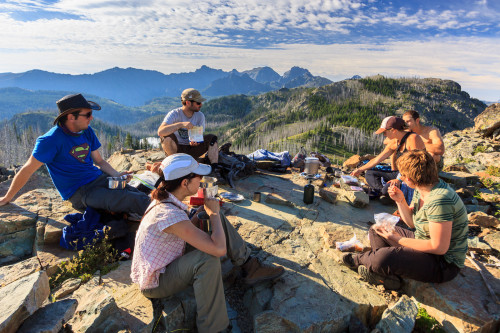What do you do when temperatures rise above 100º F?
Seek relief at very high elevations.
This June was one of the hottest on record for the northwest with several days above 100 degrees in Moscow. So when my friends proposed a backpacking trip for the Fourth of July weekend, i was a bit skeptical, especially given the location’s tendency to get hot and dry in the summer months. It’s also a very popular destination for holiday weekends, though it’s not usually accessible for the Fourth of July. So it could have been really crowded, or completely empty. They wanted to hike the 26-mile loop around the Seven Devils (30 with the Dry Diggins add-on), and since that would be a new trail for me, I was in. And so were a lot of other people. In fact, we ended up with 13 students and postdocs that wanted to get away, though not everyone was up for 30 miles or couldn’t take the extra day off of work. We ended up splitting into two groups. Five of us would hike the loop spending three nights on the trail, and the rest would meet us at Bernard Lakes for a one-night trip.
So there we were, 8:00 pm local time at the Windy Saddle Trailhead on Thursday July 2. We were one of three cars at the trailhead, so we knew we’d pretty much have the place to ourselves. We had decided to hike the first four miles to Lower Cannon Lake in order to make hiking the rest of the loop less strenuous. Of course, that was before we got the news that there were a lot of downed trees on the trail. We began making alternate plans in case we didn’t want to dodge trees for 30 miles, and that included hiking over the ridge from Cannon Lakes to Sheep Lake. Spoiler alert: We chose this option. But we’ll get to that later.
We left Windy Saddle as the sun was setting below the horizon. With clear skies and a nearly full moon, I challenged the group to night hike the four miles to our camp. So, that’s what we did. We made it to Lower Cannon Lakes without using our headlamps. It was quite an awesome experience and I wholly recommend it if you’ve never done it before. By the time we chose a campsite and set up, it was after midnight. The moon was bright, but we slept “under the stars” (mesh tent to keep the mosquitos away, but no rainfly). I was still up to catch the sunrise alpenglow on the mountains.
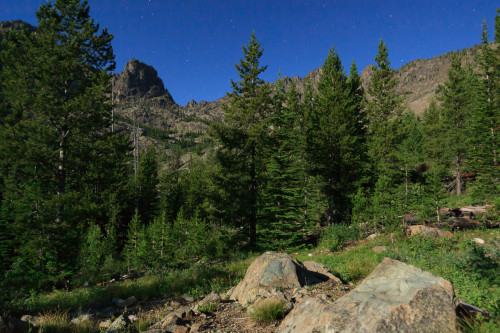
The basin around Lower Cannon Lake illuminated by moonlight.
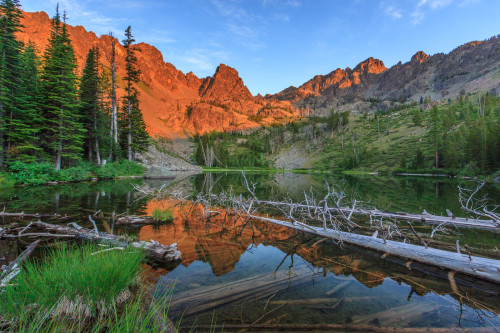
Morning Alpenglow across Lower Cannon Lake
On Friday, we were headed over to Sheep Lake. The trip begins by climbing 1000 feet up the valley to Upper Cannon Lake on an unofficial trail marked by a faint worn path and a few cairns. We began by bushwhacking up the hill from our campsite to the ridge to find the trail. But the trail is easily lost, so much of the first part of the day was spent hopping from downed tree to downed tree and trying to avoid the patches of dense bushes. It wasn’t tough though. In fact, it was quite beautiful running into wildflowers.
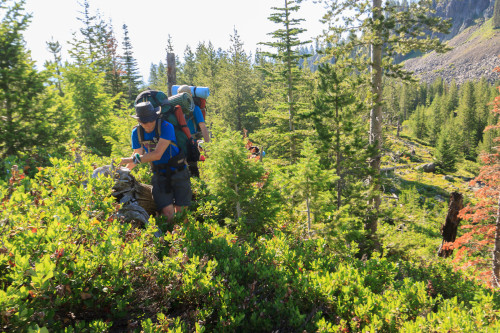
Bushwhacking up from camp.
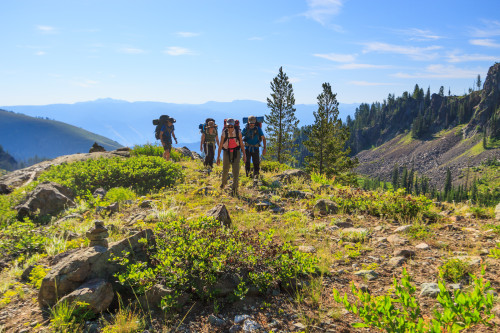
We found the trail on the little ridge.
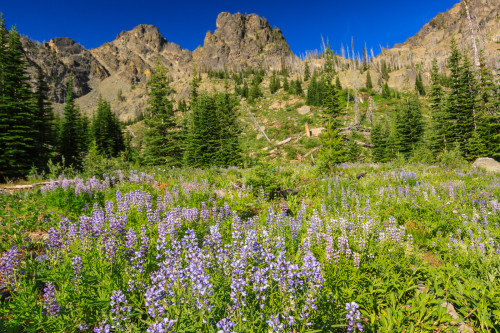
Fields of lupine in bloom color the alpine meadow.
The ridge turns into a little gorge with a series of waterfalls and cascades. The first brings us into a nice short-grass meadow lined with trees. It’s a small area with a headwall behind it. The creek drops off the wall with a nice display. We stopped to admire the waterfall, but had to climb up above it, at which point there is a second headwall to climb over before arriving at the lake. Lower Cannon Lake is at 7000 feet. The vegetation is brushy and somewhat tall. Upper Cannon Lake is at 8000 feet and most decidedly in the alpine zone. Lower Cannon is lined with shrubs and trees and is somewhat eutrophic as the summer progresses. Upper Cannon is cold, rock-lined, and clear all year. It’s a wonderful little lake, and might have been worth the extra effort to get to if we hadn’t been night hiking to our first camp. But it made for a good rest break for lunch. We had ascended approximately half of our ascent in 2.5 hours, but the next thousand feet were going to be more difficult – straight up the side of the mountain with no real trail to follow.
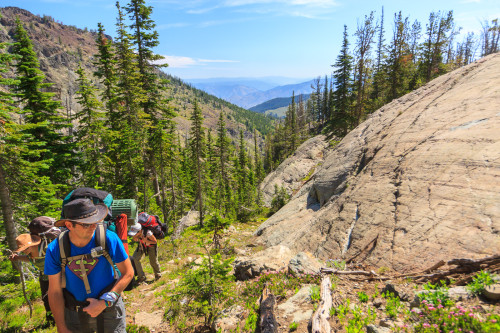
Ascending the “trail” to Upper Cannon Lake.
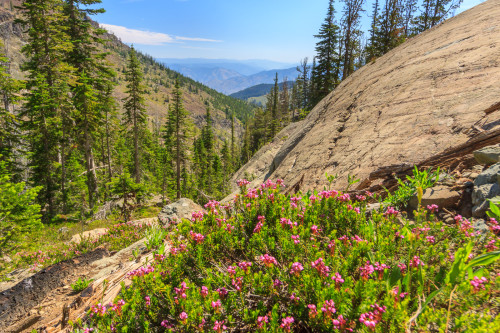
Alpine Heather in bloom on the way to Upper Cannon Lake.
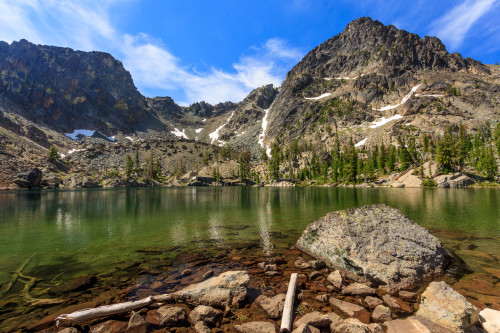
Upper Cannon Lake
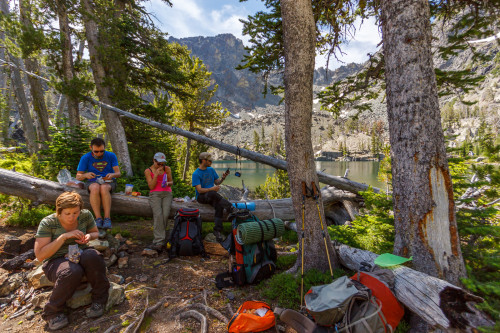
Lunch Break at Upper Cannon Lake.
From Upper Cannon Lake, we were essentially following a scree field to the ridge of the Seven Devils. It’s easy to pick out the route from the lake. Once we were on it, though, it became less clear which turns to make. In the worst case scenario, we’d make it most of the way only to turn around and try another direction. But we managed to choose the right route on the first try and were welcomed with cairns placed sporadically to validate our decisions. The ascent was tough, but ended up being easier than I expected. There were few sections of loose rock. It was mostly about keeping good footing. We reached the ridge at 9000 feet, a distance of just over half a mile in two hours. There, we had second lunch and contemplated a packless summit of the Tower of Babel and She Devil. Jessica and I tried for the Tower, but were thwarted when we discovered that the route required a descent along a screen field to skirt one of the monoliths. She devil, on the other hand, was supposed to be a straightforward scramble to the top. We could see the path from the ridge, but again, once we were on it, we kinda lost our way. Exhausted and dreading the descent down the other side, we turned back and decided it wasn’t worth the risk to make the summit at this time. The view on the ridge was good enough anyway.
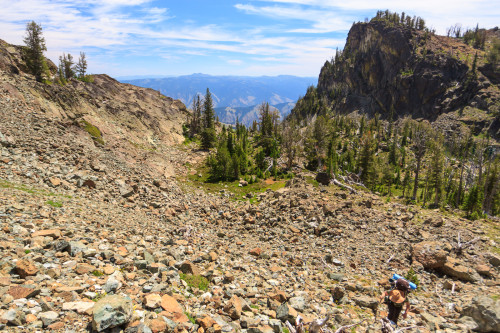
Climbing up the Scree field above Cannon Lakes.
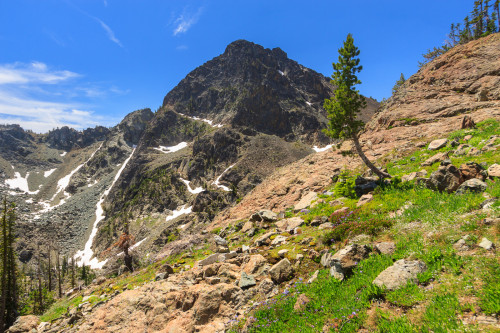
The Ogre
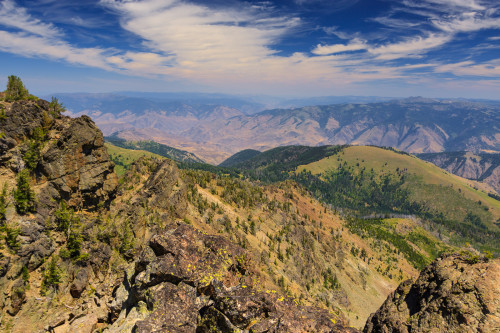
The Salmon River Canyon from the Seven Devils ridge.
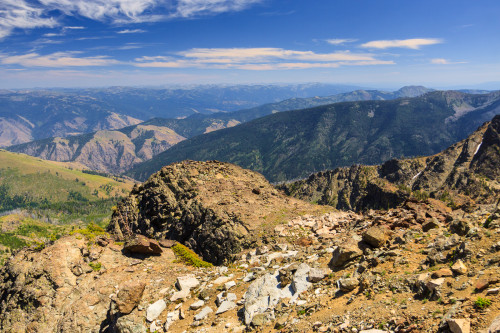
View of the mountains toward McCall
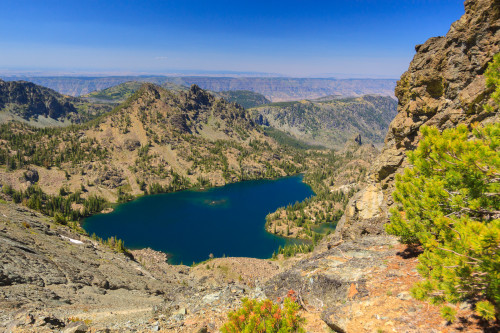
Sheep Lake
The ascent puts is in the saddle between the Tower of Babel and Mt. Baal, a small tower of rock that breaks the ridge between She Devil and the Tower. To get to Sheep Lake, we had to skirt around Mt. Baal to the saddle with She Devil. That turned out to be tougher than anticipated. When we reached the second saddle, I had run out of water. That didn’t seem like a big deal at the time. We just needed to descend a steep scree field to Sheep Lake, over one thousand feet below. That descent took two hours. Unlike the ascent, this scree field was extremely loose and we sent some large boulders tumbling down the mountain on more than one occasion. I do not recommend ever doing this with full packs. The ascent was tough, but the views at the top were an awesome reward. The descent to Sheep Lake was simply demoralizing. By the end of the day, we were sore, exhausted, dehydrated, and we hated and regretted our choice to come this way. But we were at Sheep Lake, one of the nicest lakes around, and we were greeted with a nice surprise at the bottom. There was a pack of mountain goats hanging around the shores of the side pond, and they had babies with them.

Mountain goats at Sheep Lake.
I hadn’t had a drop of water to drink in hours, and spent the past two inhaling dust kicked up during the descent. My first priority was to refill at the lake’s edge, but instead, I dropped my pack, swapped lenses on the camera and sat and watched the wildlife for a while. That’s what photographers will do for a shot.
Thankfully, Sheep Lake wasn’t too crowded this time. I’ve had trouble finding good camp sites in the past, but we found a nice one above the lake with a good view and prime access to the water. The first thing we did was dive into the lake to cool off and rinse off the sweat and grime from the day. The water was cold and refreshing, and it was the best feeling ever. I then pumped some fresh water to drink and after we changed into our camp clothes, we celebrated our perseverance with a well deserved dinner.
Side note: on small trips like these, having a cooking meal is much more satisfying than eating the dehydrated backpacker meals.

Morning sun on He Devil across from Sheep Lake.
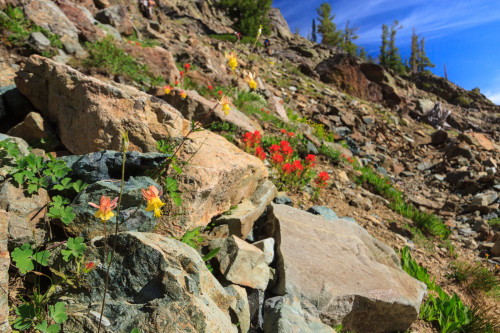
Columbine and paintbrush along the Sheep Lake Trail.
Saturday’s route took us from Sheep Lake to Upper Bernard Lake below the Dry Diggins Lookout. It was a day of hiking on established trails with relatively little elevation gain. I had hiked this trail in 2012 when everything was brown and dry, so I was excited to see the landscape while it was still green and the flowers were in bloom. I was not disappointed. The trail begins with a 500 foot climb out Sheep Lake Basin and into the next valley where we pass three lakes in succession while descending to the shelf that extends out to Dry Diggins and then drops into Hells Canyon. The third lake, Basin Lake, is most accessible from the trail and made for a great spot to stop and eat lunch. From there, it was a mile to the intersection with the Seven Devils loop, which we’d take to the Dry Diggins trail.
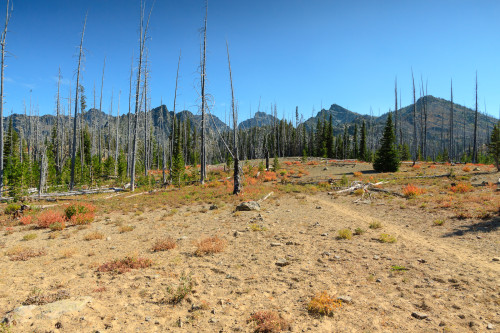
Intersection with the Seven Devils Loop in September 2012.
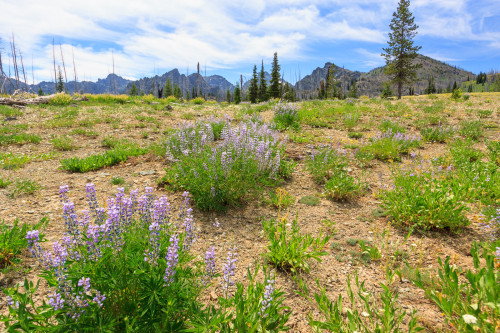
Intersection with the Seven Devils Loop in July 2015.
The trail traversed through some burned meadows that are now carpeted with wildflowers in the early spring. It then gently climbed to almost 8000 feet for a view over Dry Diggins and Hells Canyon. We then dropped steeply into a saddle where we intersect with the Bernard Lakes trail. Here, we dropped our packs and headed for the lookout before descending to the lake to make camp. Our total mileage for the day was 8 miles with lots of stops and breaks.
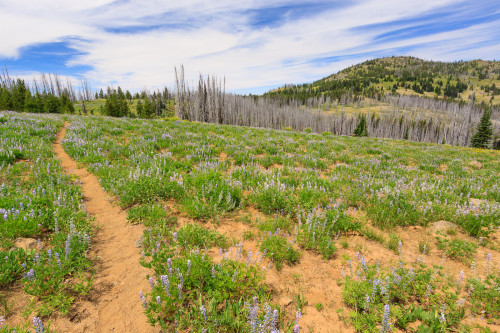
A carpet of lupins and other wildflowers surround the trail.
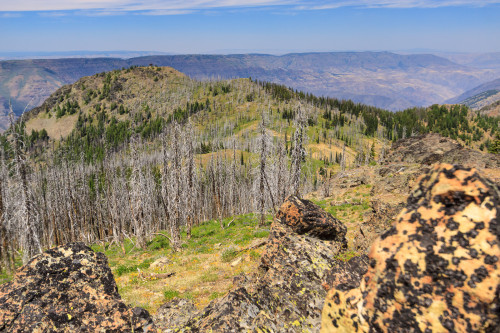
View of the Dry Diggins Lookout (ahead) and Hells Canyon behind it.
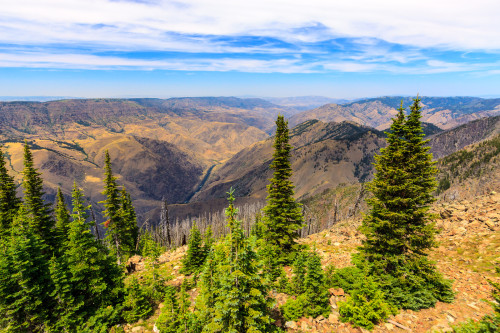
View of the Snake River from Dry Diggins Lookout. The drop to the river is over 6000 feet.
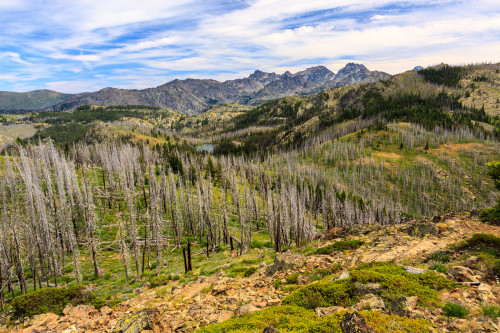
The Seven Devils from Dry Diggins Lookout.

Fires destroyed the forest, but regrowth begins with a stunning display of flowers.
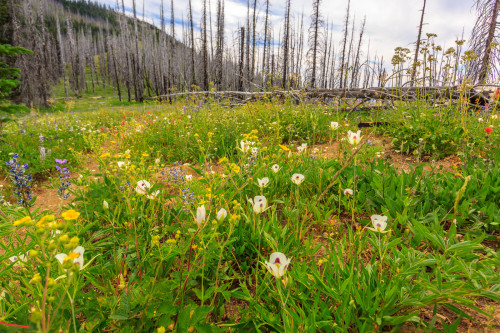
Sego Lilies are a true gem of the Seven Devils.
We arrived at our campsite on Upper Bernard Lake around 3:30. That gave us plenty of time to set up and relax while we waited for the other group of hikers to arrive. They were coming from Moscow that morning and hiking in almost 8 miles over some rough elevation changes with some first-time backpackers in the group (see day 4 in reverse). So we expected that they’d be on the trail between 6 and 8 hours, and that they’d be starting later than we did. Our Saturday hike was relatively easy in comparison, but we were still tired and sore from the previous day’s shenanigans. The first of the group made their appearance around 6:30 and the rest staggered in behind. We had ourselves a nice tent city behind the lake. We cooked dinner, swam in the lake, and sat upon the rocks watching the magnificent sunset turn the Seven Devils a deep shade of pink.
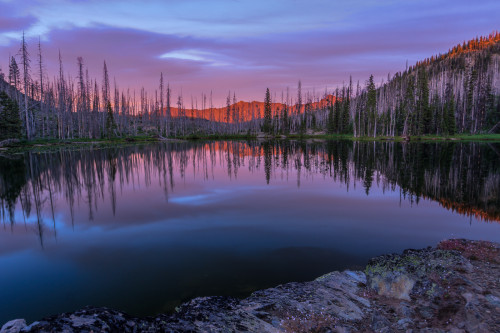
Sunset at Bernard Lake.
I initially had plans to hike up to the fire tower and capture the sunset. When we were on the tower earlier in the day, it looked as though we might have an overcast evening, but as we were making dinner, the skies cleared and the sun returned. By that time, I was tired, and so was everyone else. Still unsure whether the sunset would produce, we decided not to return to the tower that evening. And then the sunset did not disappoint. While I would have liked to have been at the tower, the lake was an excellent second choice for viewing. Instead, I suggested we get up early and hike up to the tower to catch the morning light. So that’s what we did.
The five of us, plus two from the other group, packed the stove, pots, water, and personal dishes and headed up to the tower to make breakfast. With fresh legs and light packs, the 1-mile hike to the tower was quick and easy, and the morning view did not disappoint. The sun was shining, the sky was blue, and the haze was a bit thinner than the previous afternoon. We spent an hour eating and admiring the view before heading back to pack up camp and prepare for the long trek back to the cars.
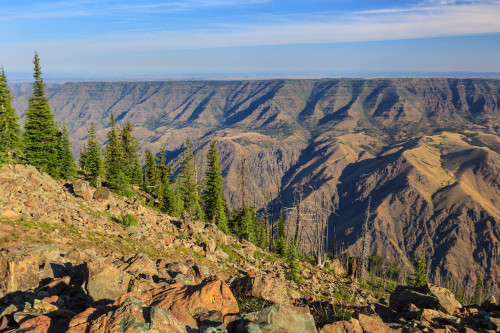
Hells Canyon
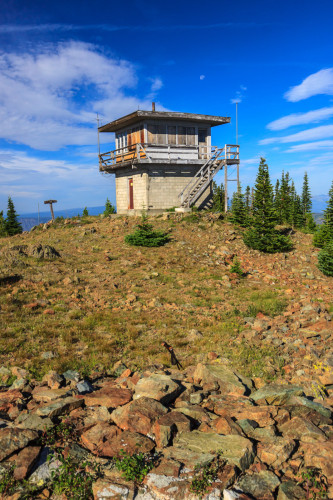
Dry Diggins fire tower.
The hike back would not be easy. The total elevation gain was about 2000 feet with a steep 500 foot section and a long and arduous 2 miles of continuous uphill for 1300 feet. Much of the trail is exposed to the sun and even though the high for the day was around 75 up there, it felt much hotter. Though I had recovered a bit from Friday’s controlled fall down the scree field, I was still tired, which made the hike out all the more difficult. Technically, it’s not all that hard of a hike. But by the end of a 4-day trip, it’s mentally exhausting. But this hike doesn’t come without its merits.
The hike began by descending into a dry basin and climbing up the other side. In two miles, we had lost and gained nearly 500 feet to meet up with the Seven Devils loop trail. Here, the trail descends rather quickly to 6500 feet into the Sheep Creek basin, pictured below. The only reprieve is that the bottom of this valley is covered in a lush forest, and the creek falls down a series of cascades to the trail. This waterfall made an excellent lunch stop and, more importantly, a place to refill with cold fresh water. This was the halfway point, but the difficulty lies ahead. After the creek, the trail climbed 1300 feet over the next two miles with each switchback deceivingly appearing as if it would be the last. At least the trail topped out with a view of Hell’s Canyon before plunging back downward into one more ravine before ascending to the finish line.
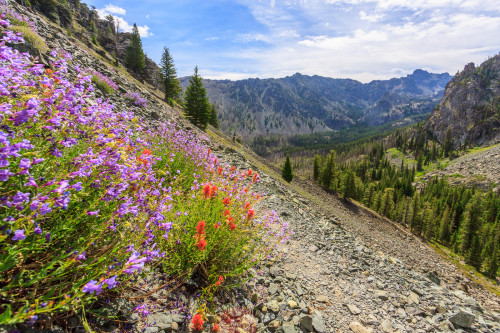
Wildflowers grow on the talus slopes as the trail descends into the Sheep Creek basin.
We made our goal of arriving at the cars by 4:00. The 8-mile hike out took only 5.5 hours. I couldn’t be happier to see the car at that point. The Seven Devils is a beautiful area with a rich diversity of flora. However, it is one of the toughest places I have hiked. Our total stats for the trip are as follows:
- Distance: 25 miles (approx.)
- Elevation Gain: 7100 feet (approx.)
- Highest point: 9100 feet (approx.)
- Lowest point: 6580 feet (approx.)
- Total Hiking Time (with breaks): 27h 46m
- Map of total route:

